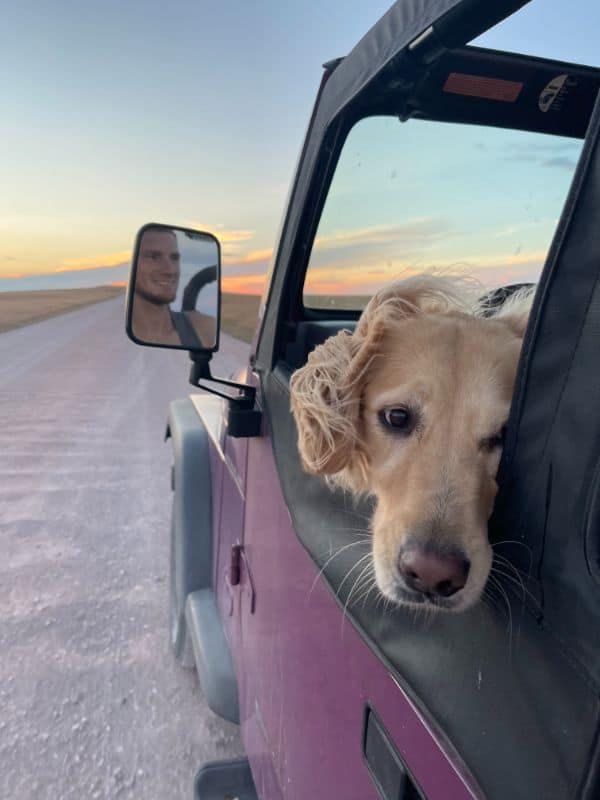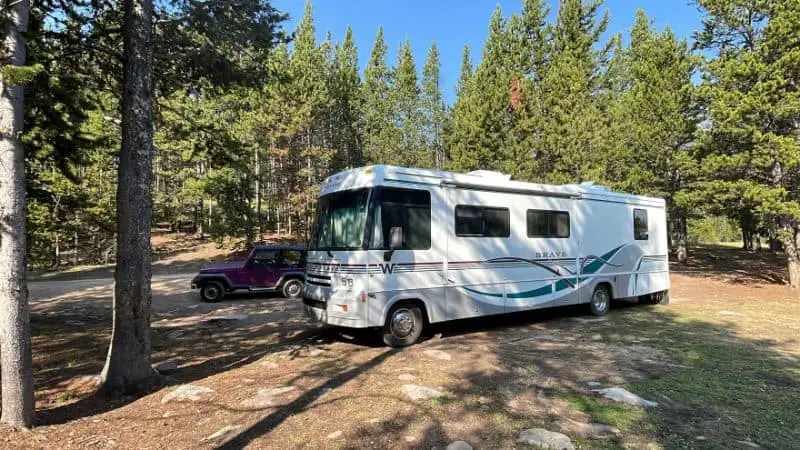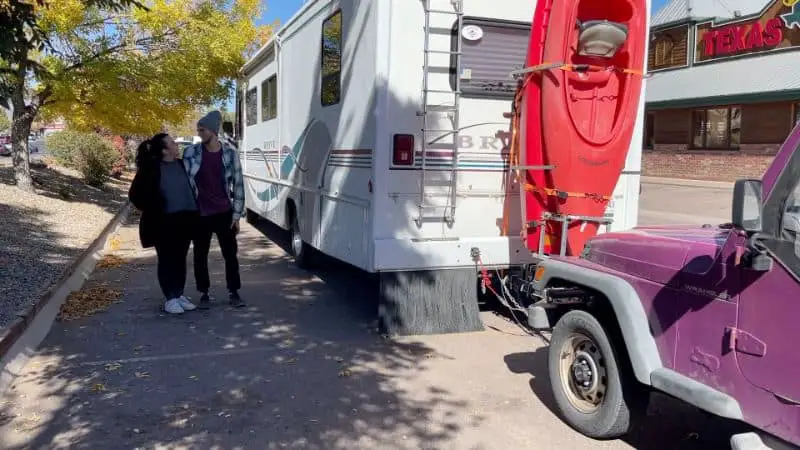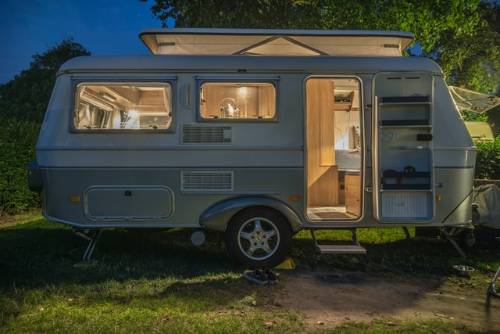To tow or not to tow? That is the question. It’s also the question my husband and I have had to ask ourselves over the years of traveling. At first, we said no. We didn’t have a reliable enough vehicle and owned a shorter Class A RV thinking that would be enough. In hindsight, we both realized how much we could have benefited from flat-towing a vehicle with us on our trip.
Flat towing is when you attach a tow bar to a suitable car, SUV or pickup, allowing the vehicle to roll along behind your motorhome on all four tires. My husband and I deliberated between flat towing and using a tow dolly for a few months. But, for many reasons, we came to the conclusion that flat towing was the answer for us.
For one, the cost of a tow bar ranges anywhere from $85 to $1,000+, whereas buying a tow dolly for your vehicle can run you anywhere between $2,000 to $4,500. Secondly, we loved the accessibility of being able to detach our vehicle with ease and only needing to store the small tow bar.
There are many things to consider when you are deciding whether or not to go with a tow dolly or a tow bar, here are a few:
- Tow bars are a lot faster to attach and detach rather than a tow dolly.
- You can reverse with a tow dolly but you can not with a tow bar.
- There is a lot more initial setup with a tow bar, i.e. safety brake, tow lights, adding coupling plates for the tow bar.
But, before the decision of how you tow your vehicle is made, you first have to decide whether you want to bring a vehicle in the first place. Here are some pros to towing a vehicle as well as some cons.
PROS OF FLAT TOWING WITH A SMALL MOTORHOME:
1. Access to roads your motorhome may not fit on.
Before we traveled with our vehicle we were extremely limited to the areas we were able to go. Whether that be within the National Parks or in cities with tight turns.

2. GAS SAVER!
The #1 money spender is: GAS. Having to take your entire rig into town to go grocery shopping or take your dog to the vet… can add up quickly. It’s the small trips bouncing around town that make a huge dent in your gas budget.
3. Scouting out your campsite.
My husband and I boondock almost exclusively when on the road. National Forest roads can be a doozy on your rig, and being able to drive out and scout the spot you want to camp in can save you major time and hassle. There were many times when we were without a vehicle and drove blindly down roads that I wouldn’t dare to take a car down, let alone our entire motorhome.

4. Being able to fully set up camp.
Since you have a vehicle with you, you are able to put your jacks down, slide your slides out, unroll your awning, and set up your camp chairs. Not having to break everything down when you want to go into town or explore is a huge win in our book.
5. SAVE MONEY!
Having a car allows you to stay at the same campsite for up to 2 weeks at a time (boondocking on National Forest and BLM land). We spend about $100+ every time we move to a new location. By not moving the RV for a long period of time, we are saving a ton of money.
CONS OF FLAT TOWING WITH A SMALL MOTORHOME:
1. Upfront expense
A tow dolly or a tow bar setup can come with a hefty initial cost. Aside from the tow bar itself you will need to have coupling plates installed on your vehicle, a safety brake installed, and either add tow lights to the rear of your tow vehicle or hook into your existing brake and turn signals.
2. Added weight
Although in the long run you save gas, your motorhome will use more gas towing a vehicle. If your going on a short trip to a campground where everything you are going to is within walking distance, you may want to consider not bringing along a tow vehicle.
3. Not all vehicles can be flat towed.
If you are looking at going the flat tow route, you have to make sure your specific vehicle can be towed. Check your vehicle’s manual to determine if it is able to be flat towed.

4. Adding ghost miles to your vehicle.
Whether you are flat towing or using a dolly your car will gain “ghost miles.” Towing will cause wear on the tires and suspension of your tow vehicle faster. Especially if you are going on long trips or long distances.

5. Trouble backing up
Tow Dolly’s are notorious for being hard to back up correctly and flat tow bars are not rated to be used in reverse. We have run into a few situations where we have needed to quickly detach our vehicle in order to reverse.
Knowing your RV and your own limits is a huge factor when looking into towing a vehicle. We have a 36’ Class A Winnebago Brave and tow a 2-door Jeep Wrangler; when everything is hooked up we are 54’ long. It’s definitely taken some time to get used to the length when taking turns and merging lanes. Making sure that you will be comfortable with the length of your rig when towing is so important.
Here is an easy way to see what the length will look like while towing: Pull the car you are considering towing behind your RV and leave about a 4’ gap between your RV and tow vehicle. This will be about the length you will be traveling with whether you decide to flat tow or use a tow dolly.
A few more things to consider…
Gas motorhomes and diesel motorhomes also have different towing capabilities. Gas motorhomes on average can tow a max of 5,000lbs, while diesel motorhomes can tow on average of 10,000lbs all the way up to 40,000lbs. Knowing the limits of your motorhome will help with tow vehicle selection as well. If you have a gas motorhome you won’t be able to tow the new Ford lightning, Hummer EV, or Tesla Model X; and other pickup trucks and SUVs will be at the max of your towing capabilities. And once you load up your RV, you won’t be able to tow anywhere close to your capacity!
Towing a vehicle is not only for 30’ plus motorhomes. The same pros apply to a 20’ motorhome. Being able to set up our campsite and run into town or drive into the National Parks has been an amazing perk. We have saved so much time and frustration by being able to jump in the Jeep and go out for the day. When we come home everything is still set up and we can make dinner and watch a movie without having to do any additional work.
Our personal experience flat towing with a small motorhome
My husband and I have experience driving our RV across the country with and without a tow vehicle. We did a trip to the west coast in a 27’ Class A RV without a tow vehicle and although it was an incredible experience, there was so much that we did not get to see because we were too large to fit on the road. We were not able to go downtown in a lot of the major cities and were unable to go to some of the most beautiful parts of the National Parks we visited. Now, don’t get me wrong, we went down a lot of roads that we were probably too large for and fit in places you wouldn’t believe, but at the end of the day having a tow vehicle would have made that trip an easier and overall better experience. We can’t imagine going without a tow vehicle, it has absolutely become a must-have for us while on the road.
-
Taylor Wrighthttps://changingears.com/author/taylor-wright/








